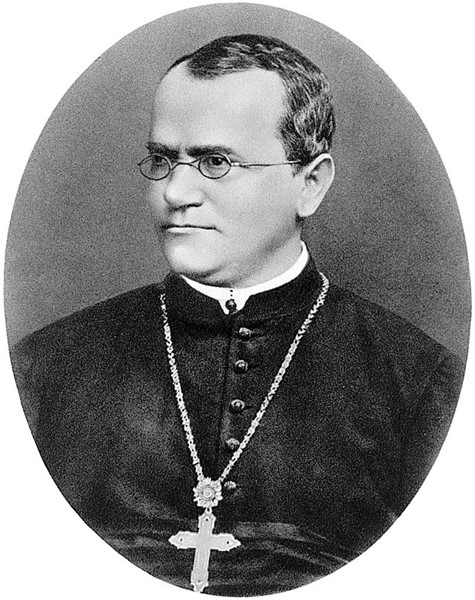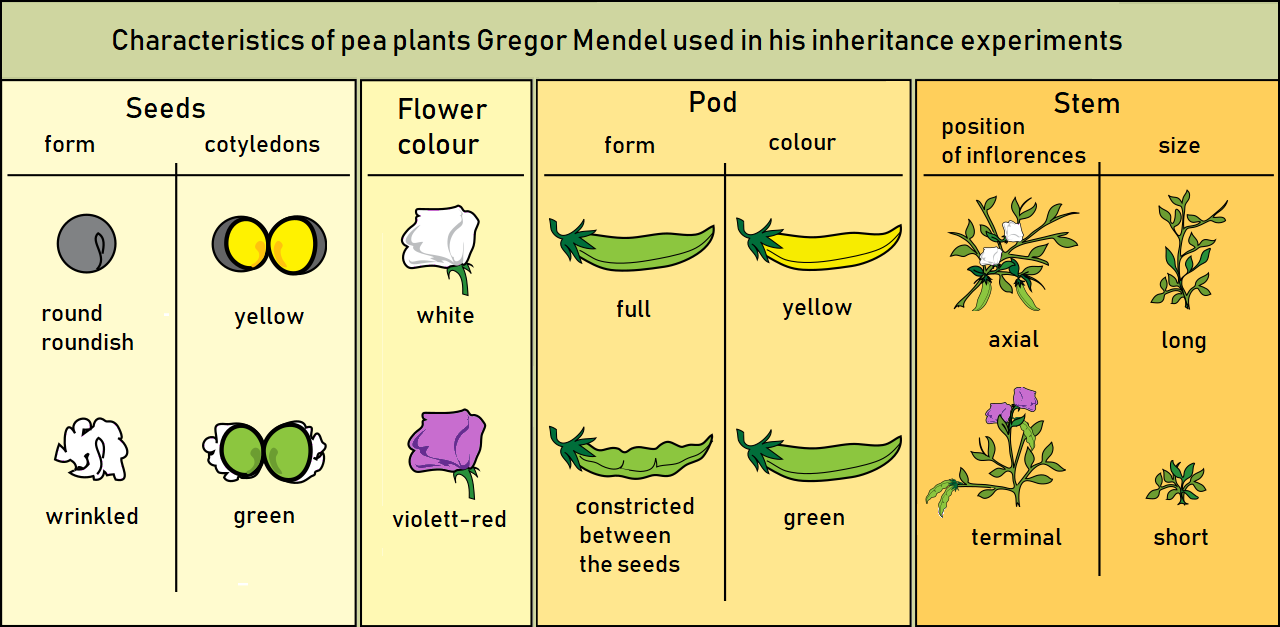1.1 Introduction
Learning Objectives
- Discuss Gregor Mendel’s discovery of the Principles of Heredity and comment on why he was successful.
- Establish and analyze monohybrid crosses.
- Describe how monohybrid crosses reveal the Principle of Segregation and the Concept of Dominance.
- Apply a test cross to identify genotypes in individuals expressing one dominant trait.
- Apply probability to predict genotypic and phenotypic ratios in monohybrid crosses.
Gregor Mendel’s Principles of Inheritance
Gregor Mendel’s principles of inheritance form the cornerstone of modern genetics. Mendel (Figure 1.1.1) was an Augustinian monk and plant breeder who conducted a series of simple, yet elegant, experiments in 1865. He was one of the first to take a quantitative, scientific approach to the study of heredity.

Mendel started with well-characterized strains, repeated his experiments many times, and kept careful records of his observations. He used the garden pea plant (Pisum sativum – Figure 1.1.2) with which to conduct his studies.


This garden pea plant was an excellent choice for Mendel, for the following four reasons:
- Peas had been shown to be true-breeding (all offspring will have the same characteristic generation after generation).
- Peas exhibit a variety of contrasting traits (purple vs. white flowers; round vs. wrinkled seeds).
- The shape of the pea flower protected it from foreign pollen. Peas usually reproduce by self-pollination, in which pollen produced by a flower fertilizes eggs in the same flower.
- Pea plants grow quickly and do not require much space.
The seven (7) traits that Mendel studied are as follows:
- Form of ripe seed (R) — smooth or wrinkled
- Colour of seed albumen (Y) — yellow or green
- Colour of flower (P) — purple or white
- Form of ripe pods (I) — inflated or constricted
- Colour of unripe pods (G) — green or yellow
- Position of flowers (A) — axial or terminal
- Length of stem (T) — tall or dwarf

After eight years of tedious experiments with these plants, Mendel proposed his foundational principles of inheritance. Mendel showed that white-flowered plants could be produced by crossing two purple-flowered plants, but only if the purple-flowered plants themselves had at least one white-flowered parent (Figure 1.1.5). This was evidence that a discrete genetic factor that produced white-flowers had not blended irreversibly with the factor for purple-flowers. Mendel’s observations disproved blending inheritance and favoured an alternative concept, called particulate inheritance, in which heredity is the product of discrete factors that control independent traits.
Through careful study of patterns of inheritance, Mendel recognized that a single trait could exist in different versions, or alleles, even within an individual plant or animal. For example, he found two allelic forms of a gene for seed colour: one allele gave green seeds, and the other gave yellow seeds. Mendel also observed that although different alleles could influence a single trait, they remained indivisible and could be inherited separately. This is the basis of Mendel’s First Law, also called The Law of Equal Segregation, which states that, during gamete formation the two alleles at a gene locus segregate from each other, and each gamete has an equal probability of containing either allele.
Genes
Mendel first made his discoveries of inheritance in the 1850s. In his 1866 publication, Experiments on Plant Hybridization, he didn’t use the word “gene” as the fundamental unit of heredity because it wasn’t coined until 1909 by Danish botanist Wilhelm Johannsen. Thomas Hunt Morgan proposed that genes resided on chromosomes in 1910, and occupied distinct regions on those chromosomes. DNA as a substance was discovered in the 1860s, but it took until the 1940s to realize that DNA was the molecule that contained the genetic information. Then in the 1950s Watson and Crick discovered the structure of DNA. Take a look at the video, “A History of Research on Genetics” by Sigma Documentaries on YouTube, which summarizes some of these landmark studies.
Watch this video, History of Research on Genetics, by Sigma Documentaries (2017) on YouTube.
Key Milestones in Genetics and Molecular Biology
Note: If you are not using the online version of this guide, you can find the timeline in Appendix A:Key Milestones in Genetics and Molecular Biology Timeline
Media Attributions
- Figure 1.1.1 Portrait of Mendel in Oval, by Hugo Iltis/Wellcome, CC BY 4.0, via Wikipedia
- Figure 1.1.2 File:Peultjes peultjes Pisum sativum mange-tout by Rasbak, CC BY-SA 3.0 via Wikimedia Commons
- Figure 1.1.3 closeup of Ka‘ū silversword pollen by Wei/ Hawai‘i Volcanoes NPS (2017), is CC PDM 1.0 (public domain mark), via Flickr
- Figure 1.1.4 Gregor Mendel, Characteristics of Pea Plants (reworked by Sciencia58), LadyofHats, CC0, via Wikimedia Commons
- Figure 1.1.5 Punnett square Mendel flowers by Madprime is licensed under CC BY-SA 3.0, via Wikimedia Commons
References
A&E Television Networks. (2009, November 24). James D. Watson and Francis H.C. Crick (image). Chemical structure of DNA discovered. History.com. https://www.history.com/this-day-in-history/watson-and-crick-discover-chemical-structure-of-dna.
Hurmerinta S. (2014, August). Day 227/366 [image]. Flickr. https://www.flickr.com/photos/explodingfish/8156844439/in/photolist-dqMXEX
Hugo Iltis/Wellcome. (2020, September 9). File:Portrait of Mendel in oval. Wellcome M0014816.jpg [image]. Wikimedia Commons. https://commons.wikimedia.org/w/index.php?title=File:Portrait_of_Mendel_in_oval._Wellcome_M0014816.jpg&oldid=453284612.
John Murray (Publisher). (2020, November 24). File:Origin of Species title page [digital image]. Wikimedia Commons. https://commons.wikimedia.org/w/index.php?title=File:Origin_of_Species_title_page.jpg&oldid=514806088.
Madprime. (2020, September 15). File:Punnett square mendel flowers.svg [image]. Wikimedia Commons. https://commons.wikimedia.org/w/index.php?title=File:Punnett_square_mendel_flowers.svg&oldid=460082081.
Maramorosch, K. (1953). Martha Chase and Alfred D. Hershey [photograph]. Linus Pauling and the Race for DNA: A Documentary History. Special Collections & Archives Research Center, Oregon State University Libraries. http://scarc.library.oregonstate.edu/coll/pauling/dna/pictures/portrait-hersheychase.html
Ruiz Villarreal, M. [user: ladyofhats]. (2018, October 9). File:Gregor Mendel – characteristics of pea plants – english [digital image – reworked by user: Sciencia58]. Wikimedia Commons. https://commons.wikimedia.org/wiki/File:Gregor_Mendel_-_characteristics_of_pea_plants_-_english.png
Rasbak. (2020, October 13). File:Peultjes peultjes Pisum sativum mange-tout.jpg. Wikimedia Commons. https://commons.wikimedia.org/w/index.php?title=File:Peultjes_peultjes_Pisum_sativum_mange-tout.jpg&oldid=488730288.
Rye, C., Wise, R., Jurukovski, V., DeSaix, J., Choi, J., Yael Avissar, Y. (2016, October 21). Figure 13.3 Inheritance patterns of unlinked and linked genes [digital image]. In Biology. OpenStax. https://openstax.org/books/biology/pages/13-1-chromosomal-theory-and-genetic-linkage. Access for free at https://openstax.org/books/biology/pages/1-introduction
Sciencia58. (2021, January 4). File:Gregor Mendel – characteristics of pea plants – english.png (image). Wikimedia Commons. https://commons.wikimedia.org/w/index.php?title=File:Gregor_Mendel_-_characteristics_of_pea_plants_-_english.png&oldid=524031116 (Original by Mariana Ruiz Villarreal/ LadyofHats)
Sigma Documentaries. (2017, January 29). A History of Research on Genetics (video). YouTube. https://www.youtube.com/watch?v=LMEy9uiu-Wk&feature=youtu.be.
Wei, J./Hawaii Volcanoes National Park. (2017). Closeup of Ka‘ū silversword pollen on a cosmetic brush for use in hand-pollinating (NPS photo). Flickr. https://www.flickr.com/photos/144356245@N06/35215975004
Wikipedia contributors. (2021, February 16). Thomas Hunt Morgan. Wikipedia. https://en.wikipedia.org/w/index.php?title=Thomas_Hunt_Morgan&oldid=1007173283
Wikipedia contributors. (2020, December 10). Wilhelm Johannsen. Wikipedia. https://en.wikipedia.org/w/index.php?title=Wilhelm_Johannsen&oldid=993478431
Long Descriptions
- Figure 1.1.1 Headshot of Gregor Mendel, the Augustinian monk, pictured with a receding hairline, wearing a black robe, spectacles and a cross around his neck. [Back to Figure 1.1.1]
- Figure 1.1.2 Garden peas appear with many green leaves, tall green stems, green pea pods, and a few white flowers. [Back to Figure 1.1.2]
- Figure 1.1.3 A medium bristled paint brush with yellow pollen dust on the tip of the brush is used for hand-pollination. [Back to Figure 1.1.3]
- Figure 1.1.4 The seven traits in garden peas Mendel experimented with are: 1) round and wrinkled seeds; 2) yellow and green seeds; 3) white and purple flowers; 4) full and constricted pods; 5) yellow and green pods; 6) axial and terminal stems; and 7) long and short stems. [Back to Figure 1.1.4]
- Figure 1.1.5 A Punnett square illustrates the segregation of alleles in male and female parents in a monohybrid cross, to produce four offspring in a 3:1 phenotypic ratio. A purple flowered male is crossed with a purple flowered female. Both parents are heterozygous (Bb). Offspring are 1 homozygous dominant (BB), 2 heterozygous (BB) and 1 homozygous recessive (bb). [Back to Figure 1.1.5]

